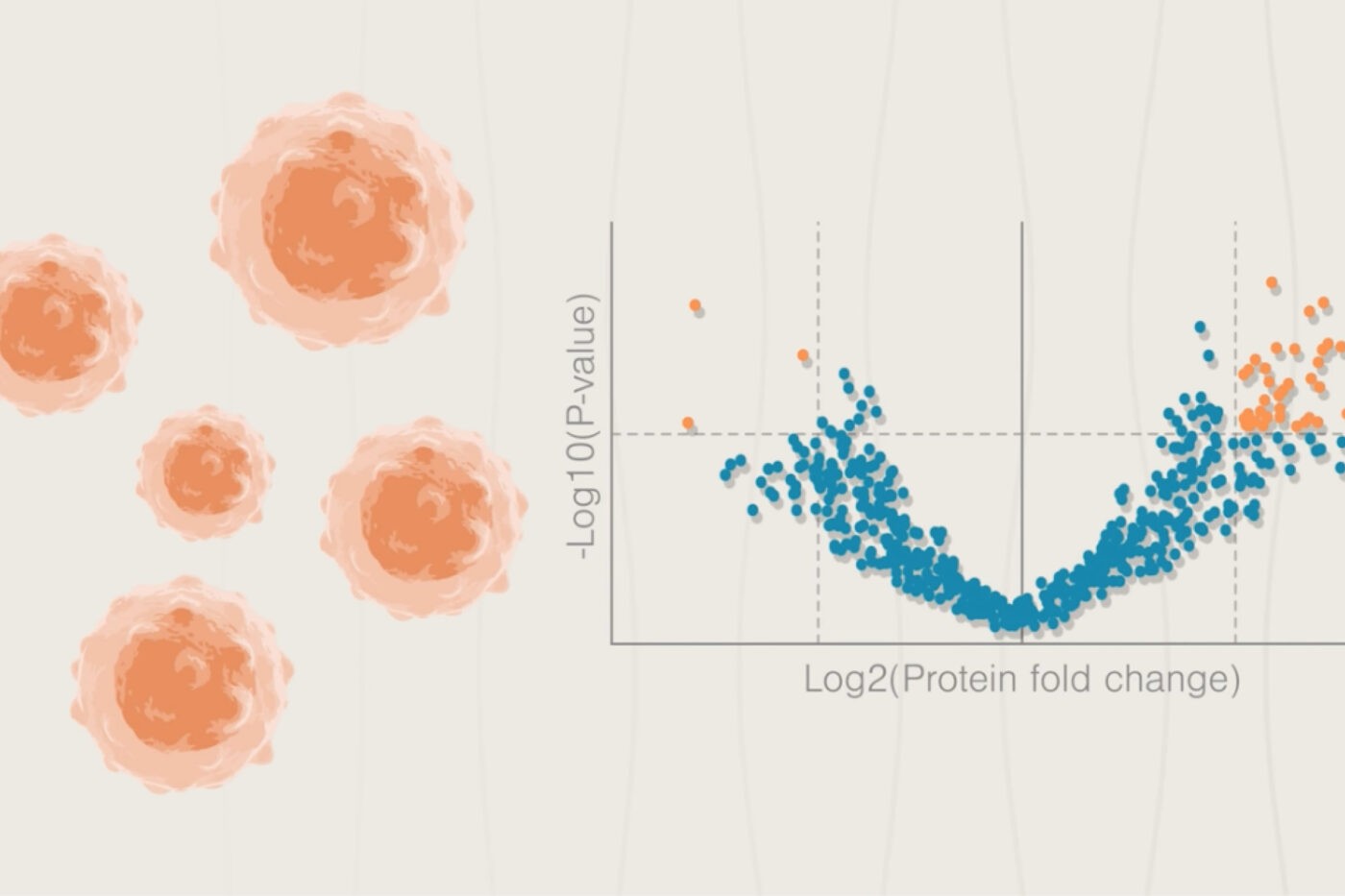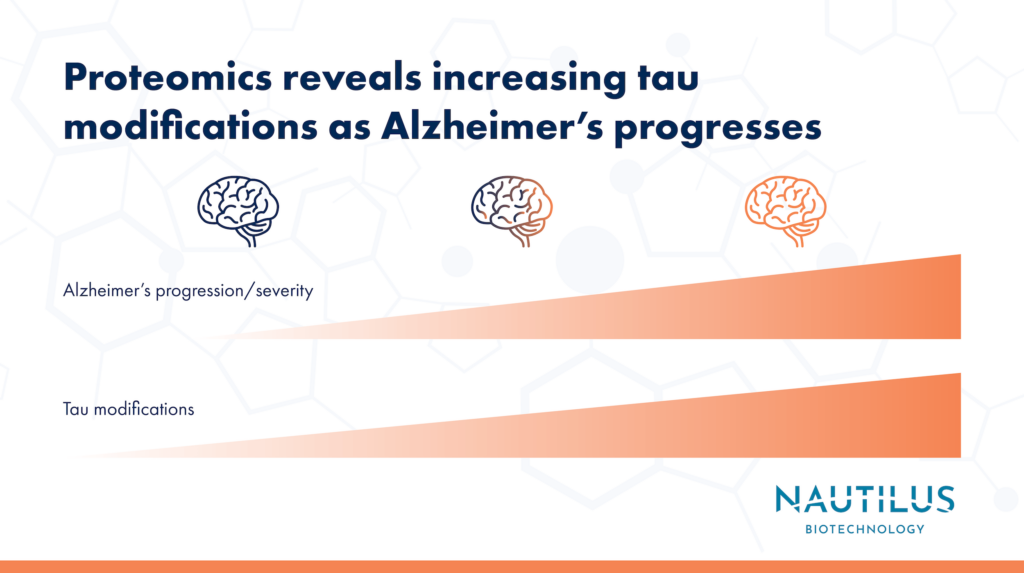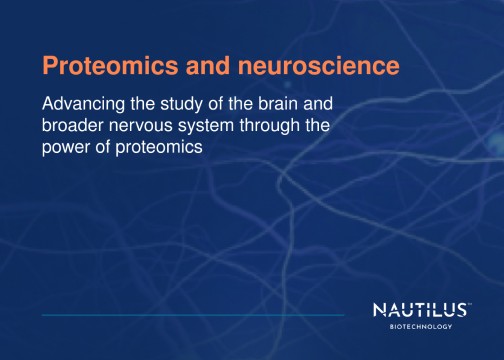
Assessing tau modifications during Alzheimer’s disease progression – Applications of proteomics in neuroscience

Tyler Ford
August 8, 2023

Alzheimer’s disease is a debilitating neurodegenerative disorder that impacts millions of people worldwide and ultimately results in death. While the molecular underpinnings of the disease are poorly understood, it is associated with the aggregation of the tau protein inside neurons. Recent proteomics research is beginning to elucidate the role tau aggregates play in this devastating disease and may lead to new Alzheimer’s diagnostics and therapies.
In this post, we cover collaborative work by Wesseling, et al wherein researchers used proteomics to identify the many ways the tau protein is modified during Alzheimer’s progression. Researchers have known for many years that tau is highly phosphorylated in Alzheimer’s, but this groundbreaking work provides a map of the types of modifications present across the tau protein and reveals the cumulative extent of modifications across tau’s component peptides. This and similar work may help researchers identify the mechanisms underlying tau aggregation and its role in disease.
A mass spectrometry-based technique for identifying tau modifications – FLEXITau
These researchers leveraged a technique known as FLEXITau to measure tau isoforms and their modifications (collectively known as proteoforms). In this technique, researchers combine internal standards with an optimized bottom-up mass spectrometry protocol to quantify modifications across tau peptides generated for mass spec. This creates maps identifying the extent of modification to the peptides and further analysis enables researchers to identify the specific modifications present. This methodology does not quantify the amount of each proteoform but provides a great overview of tau modifications.
What our animation to see how next-generation proteomics can fuel neuroscience
Tau proteoforms and Alzheimer’s progression
The researchers performed FLEXITau on postmortem brain tissue samples derived from people with Alzheimer’s as well as matched controls. When analyzing tau from these samples, they were able to correlate specific modification profiles with known levels of AD severity derived from patient data.
As has been reported in the past, these researchers found that tau was more highly modified in patients with more severe cases of Alzheimer’s disease. Importantly, in this work, researchers were able to identify the specific kinds of modifications present across tau including acetylation, ubiquitination, methylation, and phosphorylation. In addition, they identified more modified sites than had been reported in the past. The FLEXITau data also revealed which specific modifications and what level of peptide modification are best able to discriminate Alzheimer’s disease samples from controls. For instance, the authors discovered that ubiquitination of K311 and K317 and phosphorylation of T217 and S262 are strong differentiators for people with Alzheimer’s vs controls. Finally, the FLEXITau data revealed that the 0N and 4R tau isoforms are enriched in insoluble, pathologic tau fractions.
Altogether, this data enabled the development of a model for the accumulation of tau isoforms and modifications during Alzheimer’s progression. In this model, the ON and 4R tau isoforms begin to aggregate at early stages of the disease. These isoforms are modified first by phosphorylation and cleavage of the C-terminus. Later, there is further phosphorylation and subsequent ubiquitination and acetylation to neutralize the negatively charged phosphate groups. Highly modified and neutralized tau forms fibrils that cause disease progression.
These findings show that specific tau isoforms with different modifications may be more amenable targets for diagnostics and therapeutics aimed at the early and late stages of the disease.
Looking forward to future tau studies powered by next-generation proteomics
This powerful study along with others on the topic reveal the many ways tau is modified in Alzheimer’s disease. Bottom-up proteomics does not reveal the extent of modification to individual, intact tau molecules, but provides researchers with excellent insights into the modifications present in Alzheimer’s. Future work using next-generation proteomics technologies that measure proteins and their modifications at the single-molecule, intact protein level may further resolve tau proteoforms and their patterns of modification.
We’re designing the Nautilus Proteome Analysis Platform with such capabilities in mind and have begun collaborating with neuroscience researchers to develop means of measuring tau proteoforms on our platform. We aim to enable researchers to achieve single-molecule resolution of protein abundance and modification and are working tirelessly to make this platform accessible to researchers who may not be familiar with the complex workflows of mass spectrometry. We thereby aim to enable more incredible work like that of the researchers highlighted here and hope this work will elucidate the complex roles of tau and other proteins in health and disease.
Check out our round up of proteomics and neuroscience posts.
Recent further research
Wenger et al., 2023 used the FLEXITau technique to quantify tau modifications in mouse models of Alzheimer’s and compared the modification observed to those in post-mortem samples from people with Alzheimer’s. For the specific models studied, Wenger et al. found that modifications present in late-stage human Alzheimer’s were not present in the mouse models. Thus, these models may be suitable for early human disease but not late-stage disease. Similar analyses of tau proteoforms across patient samples and model systems may reveal the best models to use when studying different facets of Alzheimer’s disease.
MORE ARTICLES

